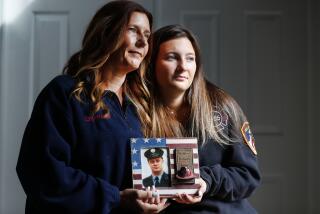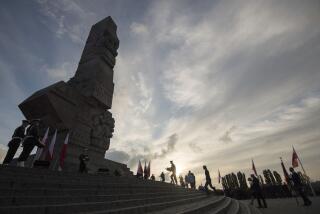Families Torn Apart by Nazis Find Closure, or One Another
BALTIMORE — Emmy Mogilensky spent 56 years tracking the fate of her parents before she learned they had been murdered in Nazi-occupied Lithuania. Paula Singer spent nearly as long looking for a cousin she still calls “Little Henry” before their tearful reunion at Los Angeles International Airport.
For both women, the search for loved ones last seen during the Holocaust era led to a nondescript office in a Baltimore industrial zone, where a small professional staff and 100 volunteers spearheads an international effort to reunite -- or bring closure to -- families separated by World War II.
The American Red Cross Holocaust and War Victims Tracing Center opened in 1990 and has compiled a huge database, culled from 47 million papers released after the collapse of the Iron Curtain, including records from the former Soviet Union and Eastern Bloc countries and seized Nazi documents. Nearly 1,200 people have been found.
“Sometimes days go by and we don’t find anyone,” said Linda Klein, the center’s director. “Then all of a sudden, we find five, six, seven in a couple of days. Everyone is jumping up and down; someone yells out, ‘I found another one!’
“There are moments when this is very sad work. But it’s a question of turning something horrible into something positive for people who are looking for information. Anyone can imagine what it must be like to awaken and find your brothers, sisters -- the whole family gone.”
Jessica Duvall, the center’s case supervisor, said a successful search was a combination of detective-like perseverance and luck. People-finder websites, Social Security death indexes, German transportation and concentration camp reports, adoption lists and data from 920 Red Cross chapters worldwide are scrutinized. The single most important piece of information the “tracing specialists” need is a date of birth.
Most of the searches, which can be initiated at any Red Cross office, take years. That’s because names on some historical lists are spelled phonetically and are not in alphabetical order. Some women’s names have changed through marriage. Some Polish towns in World War II are now in Ukraine. Documents in German and other languages must be translated. Although the Nazis kept meticulous records, they did not list by name those sent to the gas chambers, volunteers said.
“The last time I’d seen Little Henry,” Singer, 74, of Potomac, Md., said of her cousin, “was in a Belgium convent after liberation. His parents had been killed, and I was leaving for the United States with my family. We tried to get custody of him but couldn’t. When I said goodbye, he was screaming and holding onto my jacket so tight the sisters had to pry his fingers from my lapel.”
She made four trips to Belgium over the years to look for him, but there were no records. In 1997, the tracing center learned that Henry Olszyn had been adopted by an American couple shortly after the war and was living in Arizona, the father of two children.
Singer recalled the day she found her cousin. “On New Year’s Day 1998, the phone rang and a male voice said, ‘Is this Paula Singer?’ Then his voice broke, and he started to sob.” The Red Cross arranged a reunion in Los Angeles. Today the two cousins talk on the phone twice a week. They have visited each other often.
Nearly every inquiry processed by the center is forwarded to the International Tracing Service in Arolsen, Germany, the largest repository of original Nazi documents in the world. The service, administered by the Red Cross, has a database of 17 million Holocaust victims and survivors -- both Jewish and non-Jewish. The service is also assisted by the efforts of the U.S. Holocaust Memorial Museum in Washington.
“When I first came into the [Baltimore] center to interview as a volunteer, I asked, ‘Is this work depressing?’ ” said Linda Berkowitz. “The director didn’t want to answer. Well, at times it is depressing. All these people murdered. But when you find someone, especially when you’ve done a lot of work, the reward is really wonderful.”
Volunteer tracers said the most important piece of information for Jewish families searching for the fate of loved ones was the date of death so they can observe Yahrzeit -- the annual memorial day for a loved one when candles are lighted and prayers said. Non-Jewish searchers are most interested in learning the location of death, they said.
Mogilensky, 81, of Baltimore, who volunteers at the center, found the answer she had sought for more than half a century in a letter from the Lithuanian Red Cross. Her parents, Hedwig and Leo Hubert, it said, were on a Nazi train “1941, Nov. 20, carrying 100 Jews from Munich in the direction of the east. After five days, on Nov. 25, they came to Kaunas and were killed in Ninth Fort.” (At that Nazi prison, more than 9,000 Jews were executed on one day alone in October 1941.)
“There was a sense of closure and also pain and an unbelievable feeling that now my brother and I finally had the right date for Yahrzeit,” she said. “We’d simply made up a date. But now we had two dates. I went to my rabbi to ask what I should do with the date we’d been using for 56 years.
“He said, ‘Keep it. There were others murdered that day.’ So now we observe Yahrzeit on two days each year for our parents.”
More to Read
Sign up for Essential California
The most important California stories and recommendations in your inbox every morning.
You may occasionally receive promotional content from the Los Angeles Times.










